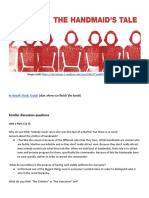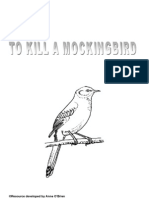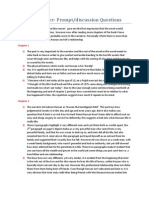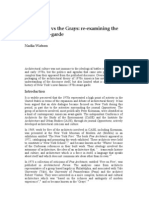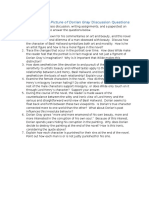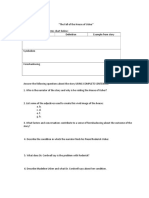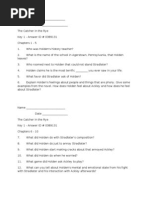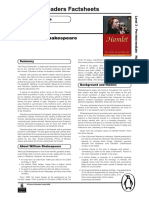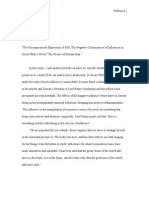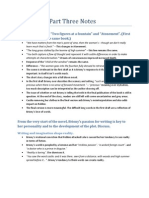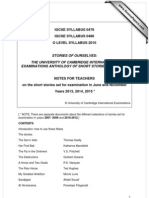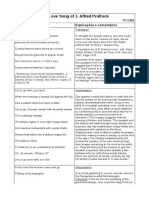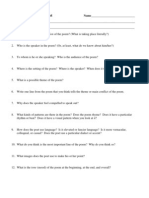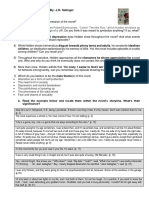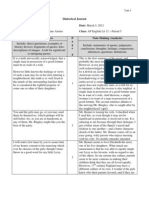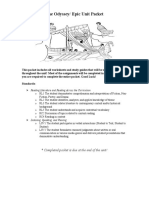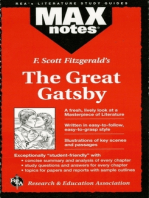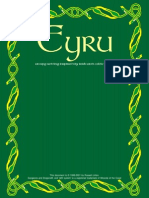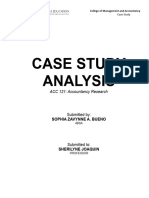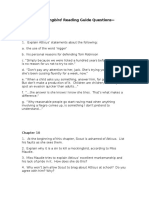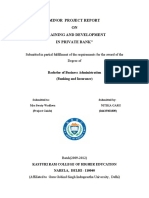Professional Documents
Culture Documents
The Pictire of Dorian Gray - Study Guide
The Pictire of Dorian Gray - Study Guide
Uploaded by
Cedric ChanOriginal Description:
Copyright
Available Formats
Share this document
Did you find this document useful?
Is this content inappropriate?
Report this DocumentCopyright:
Available Formats
The Pictire of Dorian Gray - Study Guide
The Pictire of Dorian Gray - Study Guide
Uploaded by
Cedric ChanCopyright:
Available Formats
2010 2011 AP English Literature Mrs.
Linda Winslow Name: _________________________________
Fontbonne Hall Academy Trimester 1 Study Guide #1
The Novel
The Picture of Dorian Gray by Oscar Wilde
Learning Objectives: 1. To understand how the novel is a comment on the Victorian age, 2. To describe and analyze the significance of leading a double life in Victorian England. 3. To explore the principles of the Aesthetic movement and its relation to traditional Victorian upper class society and its connection between art and life. 4. To discuss the idea of Hedonism as it pertains to the characters in the novel. 5. To analyze the novel as a commentary on social identities and social masks. 6. To analyze how the novel complicates 19th century notions of sexuality. 7. To explain and analyze the Faustian pact between Dorian and the portrait. 8. To gain skill in giving precise, meaningful oral and written responses to questions. 9. To support and verify a thesis statement using specific references to the work. Learning Activities: 1. Read The Picture of Dorian Gray by Oscar Wilde 2. Test A test will be given at the end of the unit. 3. Each student will participate in an oral presentation. 4. Essay All essays are expected to meet the guidelines of written work. Choose one of the following: A. Oscar Wildes references to sexuality and homoeroticism led to a great amount of controversy when The Picture of Dorian Gray was first published. Write a wellorganized essay in which you compare and contrast Basil Hallward and Lord Henrys attitudes toward Dorian. Consider how sexuality and platonic love play a role in the relationships between Dorian and Basil and Dorian and Lord Henry. B. Authors frequently employ elements of irony in order to reveal their attitude toward the text and to enable readers to evaluate plot developments and characters actions effectively and critically. Write a well-organized essay in which you explore the central irony of the novel.
Evaluation: Test 40% Essay 50% Participation 10% Timeline 3 cycles
Chapter 1 1. Why does Lord Henry insist that Basil Hallward should exhibit his painting of Dorian Gray? 2. Why does Basil Hallward not want to put the portrait in an exhibition? 3. How do Lord Henrys comments on marriage support the novels motif of leading a double life? 4. To what extent has Dorian Gray influenced Basils art? 5. What is Lord Henrys assessment of upper class involvement in philanthropy? 6. What does Basils hesitation to introduce Lord Henry and Dorian to each other reveal about both Basil and Lord Henry? Chapter II 1. What is Lord Henrys Opinion on the nature of influence? 2. To what extent does Lord Henrys discussion of society reflect Wildes criticism of Victorian culture? 3. How does Lord Henrys assessment of the relationship between beauty and genius exemplify the principles of the Aesthetic movement? 4. Why is Dorian upset when Basil finally finishes the portrait? 5. How does Dorian enter into a Faustian Pact with the portrait? Chapter III 1. To what extent does Lord Henry exemplify the late 18th century image of the dandy? 2. What is ironic about Lord Henrys assertion that philanthropic people lose all sense of humanity? 3. What type of relationship with Dorian does Lord Henry want to create after learning about Dorians heritage and past? 4. To what extent does Lord Henrys statement that he wants to write a novel as lovely as a Persian carpet symbolize the Aesthetic fascination with art for arts sake? Chapter IV 1. When Dorian talks to Lady Henry, what does Dorian learn about Lord Henrys marriage? 2. How do Lord Henrys comments about Sibyl Vane exemplify traditional late 18th century notions about gender? 3. In his expressed opinion of women, what comment does Lord Henry unintentionally make about Dorians masculinity? 4. Where did Dorian meet Sibyl Vane, and what does their meeting reveal about her social class? 5. What is Lord Henrys assessment of Dorians infatuation with Sibyl Vane?
Chapter V 1. How does the setting of the novel change at the onset of Chapter V? 2. What figurative language does Wilde employ in the sentence the joy of a caged bird was in her voice, and how does this use of figurative language help characterize Sibyl? 3. Why does James Vane plan to go to Australia? 4. What are Sibyls mothers hopes in regard to Prince Charming? 5. What do the hopes of Sibyls mother reveal about her character? 6. What effect is achieved by the personification employed in the sentence he could hear the droning voice devouring each minute that was left to him? 7. What is James Vanes prophetic promise in regard to Prince Charming? 8. What does James find out about his father, and how does his discovery affect his assessment of Sibyls relationship with Prince Charming? Chapter VI 1. What does Lord Henry mean when he states that being married and being engaged are two entirely different things? 2. Why is Basil concerned when he first hears about Dorians engagement? 3. What does Lord Henry reveal about his attitude toward women when he discusses Dorians engagement with Dorian and Basil? Chapter VII 1. How does Sibyls performance affect Dorian, Lord Henry, and Basil? 2. What is Sibyls explanation for acting so badly? 3. What is Dorians reaction to Sibyls explanation for her bad acting? 4. What change does Dorian notice about his portrait when he returns home? 5. How does the word choice Wilde uses to describe Dorians reaction to the portrait exemplify the themes of the novel? 6. How does the change Dorian perceives in the portrait affect his attitude toward Lord Henry? Chapter VIII 1. Why is it psychologically necessary for Dorian to write a long letter of apology to Sibyl Vane? 2. What news does Lord Henry reveal when he visits Dorian? 3. Why does Dorian call Sibyls suicide selfish? 4. How does Lord Henry help Dorian come to terms with Sibyls death? 5. What is the intended effect of the rhetorical questions toward the end of the chapter? Chapter IX 1. What prevents Basil from believing that Dorian attended the opera and what does his disbelief reveal about Basils character? 2. Why does Dorian demand to know Basils reason for being reluctant to exhibit his portrait? 3. What was Basils true reason for not wanting to display the picture? Chapter X 1. How does Dorians decision not to allow Basil to save him help characterize Dorian? 2. What does Dorian resolve to do with the painting?
Chapter XI 1. How is Dorian able to retain a good reputation even though rumors about his deplorable lifestyle are beginning to emerge in fine society? 2. How does Dorians relationship with his portrait evolve over time? 3. What effect does Dorians presence in society have on young men and women? 4. How do Dorians lifestyle and his ideals reflect the principles of Hedonism? 5. How does Dorians paranoia in regard to the portrait first emerge? Chapter XII 1. Why does Basil hesitate to believe the worst rumors he has been hearing about Dorian? How does this show that Basil is an Aesthete? 2. What is Dorian referring to when he tells Basil about the diary of his life? Chapter XIII 1. What does Dorian promise to show Basil as he takes him to his attic? 2. What is Basils reaction to seeing the portrait of Dorian? 3. What metaphor does Wilde use to describe the hatred Dorian feels toward Basil? Why? 4. How does Wildes diction and style convey Dorians emotional state and his attitude toward Basil following the murder of the painter? Chapter XIV 1. How does Dorians reaction when he awakens on the morning after the murder help characterize him? 2. How is Dorian able to persuade Alan Campbell to help him dispose of Basils body? 3. To what extent does the relationship between Dorian and Alan Campbell highlight the theme of homosexuality? Chapter XV 1. Why is Dorian not at ease during the evening at Lady Narboroughs? 2. What is the significance of the Florentine cabinet? What does the diction in the description of the cabinet reveal about his contents? Chapter XVI 1. To what extent does Basils death drive Dorian deeper into the world of illicit drugs? 2. How do the similes in this chapter illustrate the changes taking place in Dorians life? 3. How is James Vane alerted to Dorians presence at the Opium Den? 4. How is Dorian able to convince James Vane that he is not the man responsible for Sibyl Vanes death? Chapter XVII 1. How has Dorians character changed in regard to the pursuit of pleasure? 2. Why does Dorian faint in the garden during his party at Selby Royal? Chapter XVIII 1. What are some factors that could have caused Dorian to change his attitude toward Hedonism? 2. What effect is achieved by the personification in the phrase horror seemed once more to lay its hand upon his heart? 3. Why is Dorian able to cry with joy when he learns the identity of the victim of the hunting accident?
Chapter XIX 1. What does Dorian do to prove to himself that he is a reformed man? 2. What sets Dorian apart from his mentor Lord Henry, when they discuss the death of Basil Hallward? How does Wilde show the reader that Dorian is quite different from Lord Henry, even though both men seem to share the same interests and sentiments? Chapter XX 1. What does Dorian hope to see when he looks at his portrait once again? 2. Does Dorian Gray intend to kill himself?
You might also like
- Simar A Handmaid's Tale Running Document 14-20Document5 pagesSimar A Handmaid's Tale Running Document 14-20Simar ChadhaNo ratings yet
- Never Let Me Go Key Moments NotesDocument13 pagesNever Let Me Go Key Moments NotesMaire Byrne100% (1)
- Dialectical Journal For Pride & PejudiceDocument8 pagesDialectical Journal For Pride & Pejudiceapi-28460018467% (3)
- Robert Gray ContextDocument5 pagesRobert Gray ContextJack StrangerNo ratings yet
- Digital Unit Plan - Pride and PrejudiceDocument5 pagesDigital Unit Plan - Pride and PrejudiceErin Gonzalez50% (2)
- The Crucible Study Guide QuestionsDocument4 pagesThe Crucible Study Guide QuestionsDanny Trevino100% (1)
- Abridged Book and ActivitiesDocument33 pagesAbridged Book and ActivitiesMichael FoleyNo ratings yet
- Sound of Thunder Study GuideDocument2 pagesSound of Thunder Study GuideErika Totten100% (2)
- Dorian Gray QuizDocument1 pageDorian Gray Quizfuttitinni100% (1)
- 76 TB SP11 The Picture of Dorian GreyDocument2 pages76 TB SP11 The Picture of Dorian GreyLuca CastelloneNo ratings yet
- Freyas Unusual Wedding SSR 4Document3 pagesFreyas Unusual Wedding SSR 4api-462976266No ratings yet
- Dumb MartianDocument2 pagesDumb MartianSebasthosNo ratings yet
- Anne of Green Gables Chapters 30Document5 pagesAnne of Green Gables Chapters 30Aisha Usman100% (1)
- The Kite Runner-1Document6 pagesThe Kite Runner-1el04927567No ratings yet
- How To Draft A Non-Circumvention, Non-Disclosure Agreement (NCNDA) For Your International Business Venture. - International Business Law AdvisorDocument4 pagesHow To Draft A Non-Circumvention, Non-Disclosure Agreement (NCNDA) For Your International Business Venture. - International Business Law AdvisorElijah WisdomNo ratings yet
- Terms of ReferenceDocument8 pagesTerms of ReferenceABUAMMAR60100% (1)
- 3 PDFDocument59 pages3 PDFPushpam0% (1)
- Whites Vs GreysDocument15 pagesWhites Vs GreysHazem Saleh40% (5)
- Dorian Gray Discussion QuestionsDocument3 pagesDorian Gray Discussion QuestionsKrste Iliev100% (1)
- Or LaDocument8 pagesOr LaHannah HalversonNo ratings yet
- The Picture of Dorian GrayDocument6 pagesThe Picture of Dorian GrayТаня Братковская100% (2)
- English Essay Dorian GrayDocument5 pagesEnglish Essay Dorian GrayWIzKid1000No ratings yet
- Eng3u Short Story Analysis EssayDocument2 pagesEng3u Short Story Analysis EssayRudraThakurNo ratings yet
- Dorian Gray EssayDocument2 pagesDorian Gray EssayEstefanía CruzNo ratings yet
- Glass Castle PowerpointDocument8 pagesGlass Castle Powerpointapi-237430703No ratings yet
- The Fall of The House of Usher WorksheetDocument2 pagesThe Fall of The House of Usher WorksheetFatme Casal0% (1)
- To Kill A Mockingbird at A GlanceDocument4 pagesTo Kill A Mockingbird at A Glancestay goldNo ratings yet
- Catcher in The Rye Unit QuestionsDocument22 pagesCatcher in The Rye Unit Questionskcafaro59No ratings yet
- Macbeth Literary DevicesDocument5 pagesMacbeth Literary Devicesishika jain100% (1)
- The Catcher in The Rye Multiple Choice Quiz Test 1: Page 1 of 2Document2 pagesThe Catcher in The Rye Multiple Choice Quiz Test 1: Page 1 of 2janer48No ratings yet
- By Kurt VonnegutDocument4 pagesBy Kurt VonnegutJanice ReadNo ratings yet
- The Lemon OrchardDocument3 pagesThe Lemon OrchardVidya Prab50% (2)
- Penguin Readers Factsheets: by William ShakespeareDocument4 pagesPenguin Readers Factsheets: by William ShakespeareSîImoHäāķīīmNo ratings yet
- Pride and Prejudice CourseheroDocument40 pagesPride and Prejudice CourseheroSahildeep 1035100% (2)
- Introduction To Mythology and FolkloreDocument15 pagesIntroduction To Mythology and FolkloreRoushiell LondonNo ratings yet
- Essay - Dorian GrayDocument4 pagesEssay - Dorian GrayDenisa GeorgianaNo ratings yet
- When You Are Old NotesDocument2 pagesWhen You Are Old NotesChristian ConolNo ratings yet
- Atonement Part Three NotesDocument2 pagesAtonement Part Three NotesJennifer PolidanoNo ratings yet
- Stories of Ourselves Notes 2013-15Document12 pagesStories of Ourselves Notes 2013-15ferdousoic50% (2)
- Wuthering Heights NotesDocument15 pagesWuthering Heights NotesHanadi Al-QuraanNo ratings yet
- Guiding Questions - The Handmaid's TaleDocument10 pagesGuiding Questions - The Handmaid's TalePitt MaxNo ratings yet
- Acts and Key EventsDocument25 pagesActs and Key Eventsemilyjaneboyle100% (1)
- The Love Song of J. Alfred Prufrock: Text of The Poem Explicações e ComentáriosDocument6 pagesThe Love Song of J. Alfred Prufrock: Text of The Poem Explicações e ComentáriosVedran MilicNo ratings yet
- Antony and Cleopatra Questions ActsDocument2 pagesAntony and Cleopatra Questions ActsReina HeeramanNo ratings yet
- Catcher in The Rye EssayDocument4 pagesCatcher in The Rye EssayPavaoNo ratings yet
- Poetry Analysis Worksheet PDFDocument1 pagePoetry Analysis Worksheet PDFRicky EdwardsNo ratings yet
- Othello Acts 1&2 TestDocument6 pagesOthello Acts 1&2 TestJoshua DelormeNo ratings yet
- Romeo and Juliet Literary TermsDocument20 pagesRomeo and Juliet Literary TermsMadison WarrenNo ratings yet
- English Analysis The Danger of A Single StoryDocument2 pagesEnglish Analysis The Danger of A Single Storynaduni100% (1)
- The Catcher in The Rye AnalysisDocument2 pagesThe Catcher in The Rye AnalysisAna Losada PérezNo ratings yet
- The Odyssey Background and Lit TermsDocument22 pagesThe Odyssey Background and Lit TermsKeith JaredNo ratings yet
- Love Relationships Course BookletDocument120 pagesLove Relationships Course BookletonlyknowshowtoplayminecraftNo ratings yet
- Cloo P&PDocument6 pagesCloo P&Pmidnight911No ratings yet
- Theme of Relatedness in Arthur Millers's All My SonsDocument4 pagesTheme of Relatedness in Arthur Millers's All My SonsirjmssNo ratings yet
- The Crucible Essay PromptsDocument1 pageThe Crucible Essay Promptsapi-294659520No ratings yet
- The Catcher in The Rye QuizDocument4 pagesThe Catcher in The Rye Quizdrury71175% (4)
- King Lear PPTDocument19 pagesKing Lear PPTgayegaviriaNo ratings yet
- Hamlet Act 1 Scene IIDocument29 pagesHamlet Act 1 Scene IIKarin Erasmus SteynNo ratings yet
- Act 1 Quotes - MacbethDocument3 pagesAct 1 Quotes - MacbethNathan Nguyen100% (1)
- A View From The Bridge - QuestionsDocument3 pagesA View From The Bridge - QuestionsDánisaGarderesNo ratings yet
- King LearDocument105 pagesKing LearKhadijah HassaneinNo ratings yet
- Class 1 and 2 - What Is LiteratureDocument33 pagesClass 1 and 2 - What Is LiteraturemakaNo ratings yet
- The Odyssey Packet SPR 10Document10 pagesThe Odyssey Packet SPR 10Victoria RamalesNo ratings yet
- Great Gatsby, The (MAXNotes Literature Guides)From EverandGreat Gatsby, The (MAXNotes Literature Guides)Rating: 1 out of 5 stars1/5 (1)
- Rhys Davids - Dialogues of Buddha - 1Document370 pagesRhys Davids - Dialogues of Buddha - 1VirgoMore100% (1)
- An RPG Setting Inspired by Irish and Celtic MythDocument69 pagesAn RPG Setting Inspired by Irish and Celtic MythTristan Takson100% (1)
- Hack & Improve Chrome - FirefoxDocument7 pagesHack & Improve Chrome - FirefoxMorpheu100% (1)
- Euro Space Industries (M) SDN Bhd-105420-W-Fwig-Mg236142 PDFDocument3 pagesEuro Space Industries (M) SDN Bhd-105420-W-Fwig-Mg236142 PDFAnonymous BBYVRhNo ratings yet
- Case Study Analysis - Acc 121 - Sophia BuenoDocument15 pagesCase Study Analysis - Acc 121 - Sophia BuenoSophia Zavynne Ancheta BuenoNo ratings yet
- Requiem - Saint SaensDocument54 pagesRequiem - Saint SaensValerie MikhaelNo ratings yet
- Unit9 Ans WorkDocument2 pagesUnit9 Ans WorkMustafa Al Qady100% (5)
- To Kill A Mockingbird Reading Guide Chapters 9Document3 pagesTo Kill A Mockingbird Reading Guide Chapters 9api-203814269No ratings yet
- Goods and Services Tax (GST) : New GST Return SystemDocument1 pageGoods and Services Tax (GST) : New GST Return SystemSubashNo ratings yet
- United States v. Richard Thomas Hart, 407 F.2d 1087, 2d Cir. (1969)Document5 pagesUnited States v. Richard Thomas Hart, 407 F.2d 1087, 2d Cir. (1969)Scribd Government DocsNo ratings yet
- Canvas SHS Pe 3 Week 2Document3 pagesCanvas SHS Pe 3 Week 2Princess Manelle de VeraNo ratings yet
- Over Thinking WorksheetDocument3 pagesOver Thinking WorksheetAnedha AggarwalNo ratings yet
- Financial Planning and BudgetingDocument26 pagesFinancial Planning and BudgetingElaika DomingoNo ratings yet
- Cabulohan-Paradise National High School-AnnexDocument3 pagesCabulohan-Paradise National High School-AnnexRUth SanNo ratings yet
- Internal Mock Examinations 2019 Uganda Certificate of EducationDocument5 pagesInternal Mock Examinations 2019 Uganda Certificate of EducationMelvin TusiimeIsaacNo ratings yet
- Sales Blitz Template and Forms - As of May 14 2013Document3 pagesSales Blitz Template and Forms - As of May 14 2013Virtus KenoiNo ratings yet
- Anchoring SlotDocument10 pagesAnchoring SlotPankaj PeswaniNo ratings yet
- 201 Civics Questions 1Document17 pages201 Civics Questions 1andysandel3495No ratings yet
- Lugawe Vs Pacific Cebu Resort (G.r. No. 236161, January 25,2023)Document3 pagesLugawe Vs Pacific Cebu Resort (G.r. No. 236161, January 25,2023)Sam LeynesNo ratings yet
- Urdu 1 BKLT MP3 9780743596671Document40 pagesUrdu 1 BKLT MP3 9780743596671MOHAMAD HAFIZ ABDUL HALIMNo ratings yet
- (Advances in African Economic, Social and Political Development) Samuel Ojo Oloruntoba, Mammo Muchie - Innovation, Regional Integration, and Development in Africa-Springer International Publishing (20Document335 pages(Advances in African Economic, Social and Political Development) Samuel Ojo Oloruntoba, Mammo Muchie - Innovation, Regional Integration, and Development in Africa-Springer International Publishing (20Gustavo Henrique FeddersenNo ratings yet
- CF - Chap009-Stock ValuationDocument28 pagesCF - Chap009-Stock ValuationSharmila Devi0% (1)
- Minor Project Report ON "Training and Development in Private Bank"Document5 pagesMinor Project Report ON "Training and Development in Private Bank"raman_bhoomi2761No ratings yet
- Tract 90Document44 pagesTract 90esteban_martín_32100% (1)
- United States v. Randolph Williams, 962 F.2d 8, 4th Cir. (1992)Document3 pagesUnited States v. Randolph Williams, 962 F.2d 8, 4th Cir. (1992)Scribd Government DocsNo ratings yet
- Mapeh Long QuizDocument2 pagesMapeh Long QuizRehyna Relos CrudaNo ratings yet
